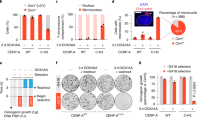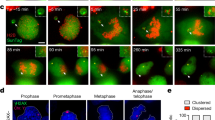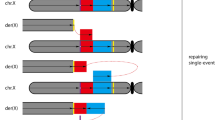Abstract
Centromere (centric) fission, also known as transverse or lateral centric misdivision, has been defined as the splitting of one functional centromere of a metacentric or submetacentric chromosome to produce two derivative centric chromosomes. It has been observed in a range of organisms and has been ascribed an important role in karyotype evolution; however, the underlying mechanisms remain unknown. We have investigated four cases of apparent centric fission in humans. Two cases show a missing chromosome 22 or 18 that is replaced by two centric ring products, a third case shows two chromosome-10-derived telocentric chromosomes, whereas a fourth case involves the formation of two chromosome-18-derived isochromosomes. In all four cases, results of gross cytogenetic and fluorescence in situ hybridisation analyses were consistent with a simple centric fission event. However, detailed molecular analyses provided evidence in support of centromere duplication as a predisposing mechanism for the observed chromosomal breakage in two of the cases. Results for the third case are consistent with direct centric fission not involving centromere pre-duplication as the likely mechanism. Insufficient material has precluded the further study of the fourth case. The data provide the first molecular evidence for centromere pre-duplication as a possible mechanism to explain the classically assumed simple “centric fission” events in clinical cytogenetics, karyotype evolution and speciation.






Similar content being viewed by others
References
Archidiacono N, Antonacci R, Marzella R, Finelli P, Lonoce A, Rocchi M (1995) Comparative mapping of human alphoid sequences in great apes using fluorescence in situ hybridization. Genomics 25:477–484
Cheng Z, Dong F, Langdon T, Ouyang S, Buell CR, Gu M, Blattner FR, Jiang J (2002) Functional rice centromeres are marked by a satellite repeat and a centromere-specific retrotransposon. Plant Cell 14:1691–1704
Choo KHA, Earle E, McQuillan C (1990) A homologous subfamily of satellite III DNA on human chromosomes 14 and 22. Nucleic Acids Res 18:5641–5648
Darlington CD (1939) Misdivision and the genetics of the centromere. J Genet 37:341–364
Del Porto G, Di Fusco C, Baldi M, Grammatico P, D’Alessandro E (1984) Familial centric fission of chromosome 4. J Med Genet 21:388–391
Dennehey BK, Gutches DG, McConkey EH, Krauter KS (2004) Inversion, duplication, and changes in gene context are associated with human chromosome 18 evolution. Genomics 83:493–501
Devilee P, Cremer T, Slagboom P, Bakker E, Scholl HP, Hager HD, Stevenson AF, Cornelisse CJ, Pearson PL (1986) Two subsets of human alphoid repetitive DNA show distinct preferential localization in the pericentric regions of chromosomes 13, 18, and 21. Cytogenet Cell Genet 41:193–201
Egozcue J (1971) A possible case of centric fission in a primate. Experientia 27:969–970
Fredga K, Bergstrom U (1970) Chromosome polymorphism in the root vole (Microtus oeconomus). Hereditas 66:145–152
Goidts V, Szamalek JM, Hameister H, Kehrer-Sawatzki H (2004) Segmental duplication associated with the human-specific inversion of chromosome 18: a further example of the impact of segmental duplications on karyotype and genome evolution in primates. Hum Genet 115:116–122
Iafrate AJ, Feuk L, Rivera MN, Listewnik ML, Donahoe PK, Qi Y, Scherer SW, Lee C (2004) Detection of large-scale variation in the human genome. Nat Genet 36:949–951
Janke D (1982) Centric fission of chromosome no. 7 in three generations. Hum Genet 60:200–201
Kaszas E, Birchler JA (1996) Misdivision analysis of centromere structure in maize. EMBO J 15:5246–5255
Kaszas E, Birchler JA (1998) Meiotic transmission rates correlate with physical features of rearranged centromeres in maize. Genetics 150:1683–1692
Kolnicki RL (2000) Kinetochore reproduction in animal evolution: cell biological explanation of karyotypic fission theory. Proc Natl Acad Sci USA 97:9493–9497
Lichter P, Cremer T (1992) Chromosome analysis by non-isotopic in situ hybridisation, 2nd edn. IRL Press, Oxford
Marzais B, Vorsanova SG, Roizes G, Yurov YB (1999) Analysis of alphoid DNA variation and kinetochore size in human chromosome 21: evidence against pathological significance of alphoid satellite DNA diminutions. Tsitol Genet 33:25–31
Miller K, Pabst B, Ritter H, Nurnberg P, Siebert R, Schmidtke J, Arslan-Kirchner M (2003) Chromosome 18 replaced by two ring chromosomes of chromosome 18 origin. Hum Genet 112:343–347
Perry J, Slater HR, Choo KHA (2004) Centric fission—simple and complex mechanisms. Chromosome Res 12:627–640
Rivera H, Cantu JM (1986) Centric fission consequences in man. Ann Genet 29:223–225
Saffery R, Irvine DV, Griffiths B, Kalitsis P, Wordeman L, Choo KHA (2000) Human centromeres and neocentromeres show identical distribution patterns of >20 functionally important kinetochore-associated proteins. Hum Mol Genet 9:175–185
Sambrook J, Fritsch EF, Maniatis T (1989) Molecular cloning: a laboratory manual, 2nd edn. Cold Spring Harbor Laboratory press, Cold Spring Harbor
Samonte RV, Eichler EE (2002) Segmental duplications and the evolution of the primate genome. Nat Rev Genet 3:65–72
Sebat J, Lakshmi B, Troge J, Alexander J, Young J, Lundin P, Maner S, Massa H, Walker M, Chi M, Navin N, Lucito R, Healy J, Hicks J, Ye K, Reiner A, Gilliam TC, Trask B, Patterson N, Zetterberg A, Wigler M (2004) Large-scale copy number polymorphism in the human genome. Science 305:525–528
Sinha AK, Nora JJ, Pathak S (1971) Isochromosomes arising from a human “C”-autosome. Hum Hered 21:231–237
Southern DI (1969) Stable telocentric chromosome produced following centric misdivision in Myrmeleotettix maculatus (Thunb.). Chromosoma 26:140–147
Sullivan BA, Willard HF (1998) Stable dicentric X chromosomes with two functional centromeres. Nat Genet 20:227–228
Takagi N, Sasaki M (1974) A phylogenetic study of bird karyotypes. Chromosoma 46:91–120
Todd NB (1970) Karyotypic fissioning and canid phylogeny. J Theor Biol 26:445–480
Tyler-Smith C, Oakey RJ, Larin Z, Fisher RB, Crocker M, Affara NA, Ferguson-Smith MA, Muenke M, Zuffardi O, Jobling MA (1993) Localization of DNA sequences required for human centromere function through an analysis of rearranged Y chromosomes. Nat Genet 5:368–375
Willard HF (1991) Evolution of alpha satellite. Curr Opin Genet Dev 1:509–514
Acknowledgements
We thank Robert Robertson and Lesley Ades for patient materials, and Lee Wong and Kerry Fowler for help with quantitative FISH and statistical analyses. J.P. is a Peter Doherty Fellow, and K.H.A.C. a Senior Principal Research Fellow of the National Health and Medical Research Council of Australia.
Author information
Authors and Affiliations
Corresponding authors
Rights and permissions
About this article
Cite this article
Perry, J., Nouri, S., La, P. et al. Molecular distinction between true centric fission and pericentric duplication-fission. Hum Genet 116, 300–310 (2005). https://doi.org/10.1007/s00439-004-1209-4
Received:
Accepted:
Published:
Issue Date:
DOI: https://doi.org/10.1007/s00439-004-1209-4




